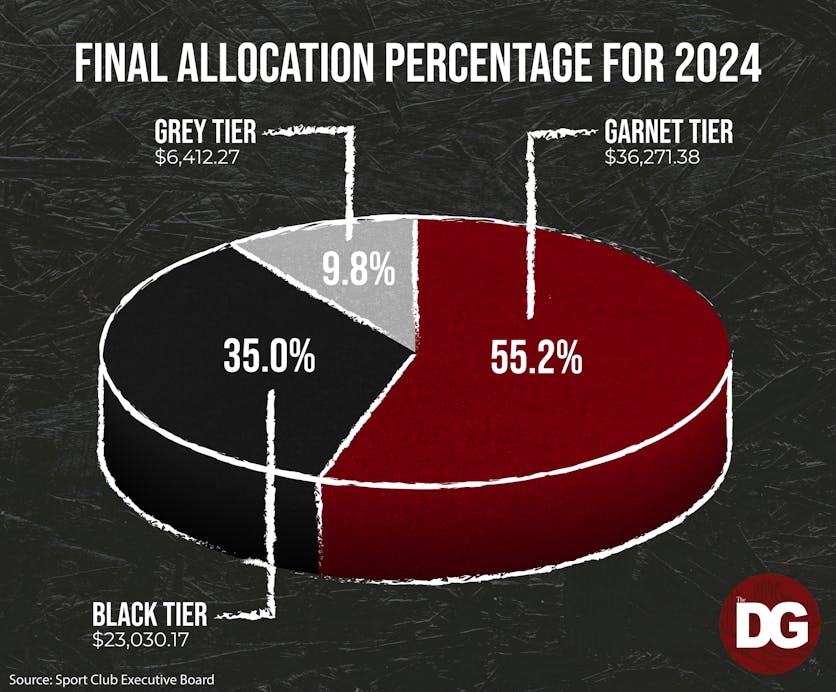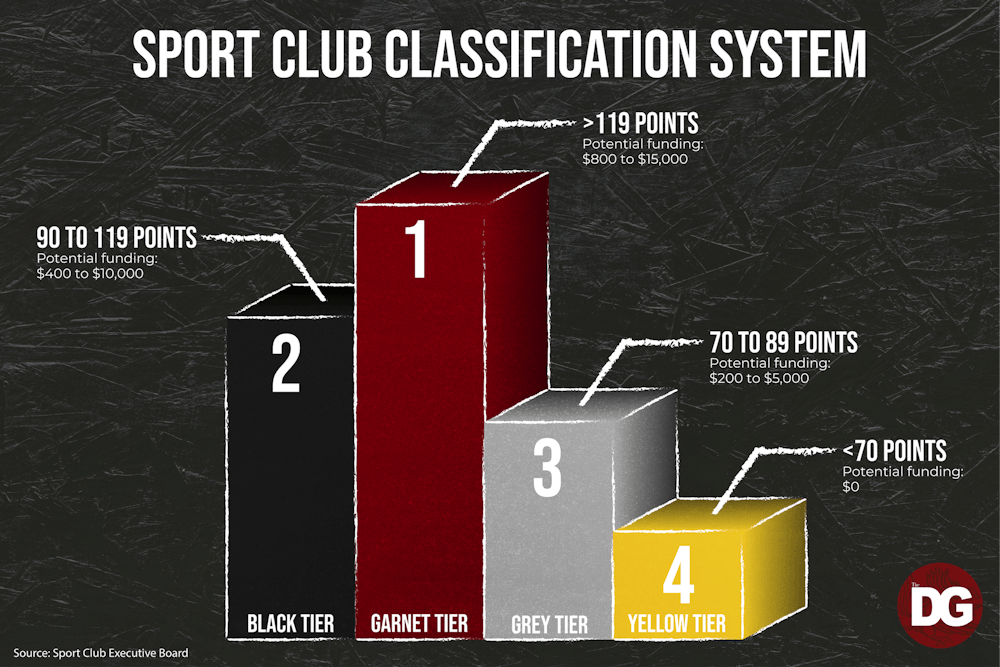The South Carolina women's club soccer team received a bid to nationals in October for the first time in program history.
But with nationals being in Texas, fourth-year hospitality management student Sydney Mcghee was skeptical about whether they were going to be able to make the trip. The team decided to try using allocated funds, as well as alternative methods, to help pay for the trip.
“I was nervous," Mcghee said. "In the back of my head, I was like, ‘Okay, cool. We won, but how are we going to get there?'”
Funding for club sports is different compared to other clubs on campus, as they rely on the Sport Club Executive Board to receive money. Clubs must pitch to the board how much money they need for the academic year.
Club sports can't request funds from both the Sport Club Executive Board and Student Government, limiting their options when it comes to funding. The club also has to explain how they plan to use these funds, so the board knows the money is going to good use.
The Sport Club Executive Board is more likely to prioritize requests for things such as equipment and rental fees because reimbursement can often happen directly.
But pitch meetings are not the only factor the board takes into account when allocating funds.
The board follows a point system to determine how much money to give to different clubs, which is then used to place the clubs into tiers based on their number of points. The highest tier is referred to as garnet, followed by black and then grey. There is also a yellow tier for any clubs that are on probation, assistant director of sport programs James Harris said.
The amount of money a club can receive is based on which tier it falls into. The garnet tier can receive anywhere from $800 to $15,000, the black tier $400 to $10,000 and grey $200 to $5,000.

Higher tiers can be granted some of the lower tiers' unused money to ensure that they have proper funding for the season, Harris said. For example, clubs within the garnet tier are able to receive some of the money from clubs in the black tier, and the same applies down the line. This encourages clubs to earn as many points as possible to receive more funding.
Clubs must earn a certain number of points to qualify for the garnet tier, said Ryan Everding, the co-president of the board and a third-year finance and economics student. But that's not the only requirement needed to reach the highest rank.
"We're also looking for clubs to work in the community,” Everding said. “So to get in the garnet tier, you have to have 120 classification points and four hours of community service per member, so our goal is that we're giving back to the community.”
There are several ways organizations can earn points, and some of them are required by the board and Campus Recreation.
These include tasks such as making sure there are a minimum of two club members that are CPR-trained — which is worth 30 points — and confirming that paperwork is completed correctly, whether that be spending requests or waivers for teams — which ranges from 50 to 60 points.
Clubs can be in a position known as the yellow tier, where they don't receive any money from the board. The tier is for any club that has 69 points or fewer.
If a club completes only the minimum requirements and one community service hour per member, then it would be placed in the grey tier, which falls into the 70 to 89-point range.
“With those required portions, that is our threshold of the yellow tier. As long as you complete all of those, you stay out of the yellow tier,” Harris said.
Club sports have found other ways to raise money that aren't directly allocated from the board, as well. The women's club soccer team sells merchandise, hosts percent nights and requires dues from each club member to participate. These methods assist clubs in raising funds that the board couldn't provide.
The funding received can be spent in a variety of ways, whether that be for practice rentals, uniforms or equipment.
Everding, who is also the vice president of the men's club volleyball team, said a majority of the team's funding goes to travel. Men's club volleyball will use much of its funds for a national tournament in Kansas City, Missouri, that takes place at the end of April.
The team had to pay $1,000 just to register for the tournament and spent $3,000 on hotels in Kansas City.
"That’s pretty much all of our — the majority of our budget.” Everding said.
Travel is a major obstacle for club sports teams, as many organizations have games or tournaments outside of the state. This requires club members to pay out of pocket for things such as gas, with the club reimbursing them later on, said Emily Clune, the co-president of the women's club soccer team and a second-year finance and supply chain student.
"We drive ourselves and then reimburse our drivers for gas, so it's a lot of carpooling, which is great team bonding, but it's hard on our dues," Clune said. "On top of that, staying in hotels is very expensive, especially when our team has 32 girls."
Travel expenses take longer to process than other expenses, such as rental or equipment fees. Harris said it is preferred that teams do not spend allocated money on travel.
Any time a team uses funds for travel, they are required to complete a travel authorization form. The process can take at least four weeks due to the multiple levels of approval needed, according to the Sport Club Officer Manual. Teams such as men's club volleyball choose not to use university funds on hotels despite it sometimes being necessary for out-of-state competitions.
The women's club basketball team plays a majority of its games outside of the state, said third-year neuroscience student Gabby Schwartz, who serves as the club's treasurer. Schwartz said the club had to create a second team due to the amount of girls trying out, which doubled its expenses.
“As the treasurer, I'm in charge of booking all our hotels and arranging all of that travel. For pretty much all of our games and tournaments, we do go out of state,” Schwartz said. “It does get expensive to have three or four hotel rooms for two nights.”
The team also qualified for nationals, which took place in Wisconsin in mid-April. The postseason tournament adds more expenses, with registration fees amassing $775. With the need to cover flights, rental cars and hotel rooms, the team used a GoFundMe to help raise the remaining amount.
“This year, with two teams and with the nationals trip, we definitely needed a lot more," Schwartz said. "The stuff left over couldn’t sustain all of that."
The women’s club soccer team also turned to GoFundMe to help pay for its trip to nationals at the end of 2023 after it allocated $500 for the season.
Clune, who serves as the club's president, said the team had to raise more than $8,000 for its trip to Round Rock, Texas, which included expenses such as flights and hotels.
The trip cost four times the amount the club needed to get to regionals in Henrico, Virginia, earlier that year, Clune said.
The board tries to help by taking unused money from other sport clubs and redistributing it to ones that still need funding for postseason competitions, Harris said.
Clune said she believes there is not enough funding to support club sports on campus. She wishes the university would do a better job of promoting club sports and supplying the teams with more funding, she said.
“We work very well with the club sports program and their leaders. ... They do a great job, and they support us a lot. I think whoever gives them the money isn’t doing a good job to support us,” Clune said. “There's a lot of other programs that are struggling that should be able to continue their charter, but sometimes they can’t because of money issues. And that's not fair.”

